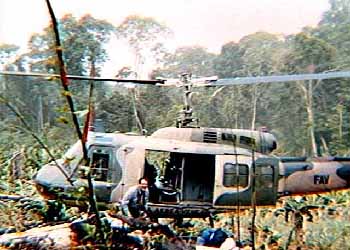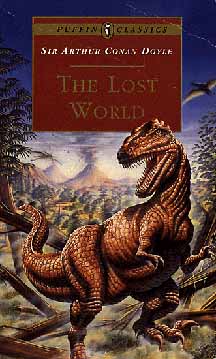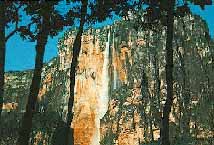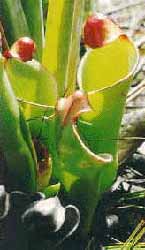|
|

© copyright 2003 Michael P.
Hamilton, Ph.D.
So where are the dinosaurs?

July 30, 1987:
The pilot signaled us to come aboard, so we ducked
our heads,
ran like heck over to the Hughes military helicopter,
and
climbed inside. I had asked the commander in charge
of this
flight if we could have the door removed to gain an
unobstructed
view for shooting video and movie film. He agreed,
so our flight
would be rather noisy and windy ... and very exciting.

book cover of Sir Conan Doyle's novel "The Lost World"
It was time to visit one of the most unusual ecological
features
in all of Venezuela, the Tepui mesas of the Gran Sabana.
When Sir
Arthur Conan Doyle wrote his famous novel 'The Lost
World' he
based his adventure on the exploration of this little
known region of
Venezuela. The Tepui are a series of ancient mountains
formed by the
breakup of the continents of South America and Africa
millions of years ago. As massive geological forces
gradually lifted
the land, erosion from ancient rivers, rainfall and
wind weathered
away the more porous materials, exposing these flat-topped
mesas.
Geology, topography and climate eventually isolated
the tops of the
mesas from each other and the connecting landscape
below. Arthur
Doyle speculated in his fictional story that relict
dinosaurs still
existed on the tops of these prehistoric Tepui, unable
to leave because of
the thousand foot cliffs. Today it was our turn to
see if the dinosaurs
really existed!

Angel Falls, Venezuela
The Gran Sabana is an extraordinary place. The tallest
waterfall in the
world, Angel Falls, plunges nearly 3,000 feet from
the summit of
Ayuan Tepui. Looking through the viewfinder of my
camera I filmed a
landscape of flat top mountains, deep green rainforests
and large
expanses of grasslands and palm trees. There were
no roads or
other evidence of human habitation in the direction
we were travelling.
Our destination was to ecologically survey the top
of Mount
Drivoa, and to collect a rare carnivorous pitcher
plant called Heliamphora.
After two hours of travel the pilot informed us that
we were
approaching the summit of the mountain, and to prepare
to land. Much
of the lower elevations of the mountain was shrouded
in a thin white mist,
but fortunately for us the upper reaches were in full
sunlight. There is
nothing quite like a helicopter to get around in normally
inaccessible places. I've been spoiled over the years
in having the use
of helicopters to study wildlife in Alaska, endangered
plants in
Nevada and Utah, and bighorn sheep in our local
Santa Rosa Mountains.

Heliamphora, The Venezuela Sun Pitcher
It didn't take us long to unload the helicopter and
watch it depart,
then set up camp and begin our botanical survey. A
well-known
Venezuelan botanist, Dr. Otto Huber, was with us on
this expedition,
and he being quite familiar with the location, we
soon discovered
the first specimen of Heliamphora minor, the
Venezuelan pitcher
plant. Pitcher plants are unusual members of a larger
group of
carnivorous plants that derive their primary nutrition
from animals.
Their leaves have evolved into ingenious watery traps
that attract and
ensnare insects. Slippery wax and downward pointing
hairs around
the rim of each pitcher-like leaf keeps unwitting
insects from
climbing out until they drown. Specialized enzymes
secreted
by the cell walls of the pitchers rapidly break down
the softer body parts, making food that sustains these
plants
that ordinarily grow in nutrient-poor acid bogs. Pitcher
plants exist
in Australia, southeastern and northwestern US, the
jungles of southeast
Asia, and the rarest here in Venezuela.
These are heady times for young biologists, exploring
tropical
mountains that fewer than 100 people have ever seen.
Before our
helicopter returned to take us back to civilization
we had collected
nearly a hundred specimens of rare and exotic plants,
and captured
what we hoped to be at least a dozen new species of
animals,
including bats, frogs and insects. Nowhere in our
wanderings
did we come across the dinosaurs described in 'The
Lost World' ...
but you should know we spared no small effort in trying!

previous journal entries
|